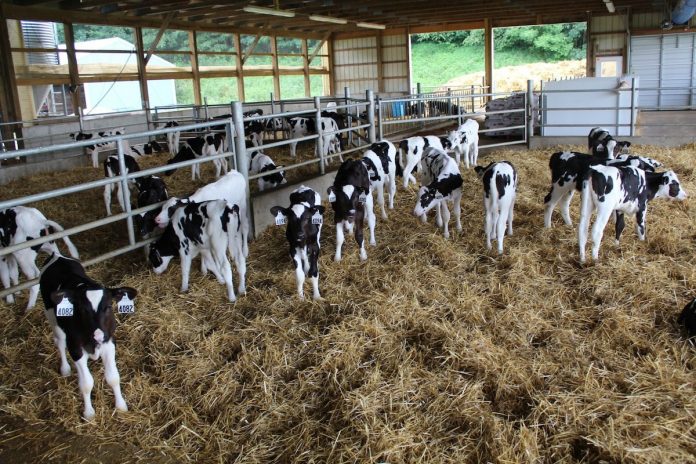In 1994, Swedish researchers set out to determine the “ideal” natural environment for beef and dairy cows to give birth. Researchers gave both beef and dairy dams access to large acres of land and recorded where the cows chose to calve.
Regardless of breed, a majority of the cows left the herd to find a hidden, secluded area to calve, using tall grass or tree cover when it was available. Cows also sought dry patches that were “bedded” with dried leaves or grasses. In Ohio and across the U.S., providing access to large ranges for dairy cows to give birth is not common, nor practical.
According to the USDA, a majority of herds either calve cows in individual maternity pens or in groups. Both options come with their advantages and disadvantages — on the one hand, moving a cow into an individual pen requires labor to detect imminent calving, and move the cow without disturbing labor. Calving in groups requires minimal extra labor, but calves born into groups may suckle.
Close watch
A common location for calving pens is near the office or parlor, where there is a lot of foot traffic. This location allows producers to keep close watch on cows during labor in case intervention is needed, and it creates a short walk for the cow to the parlor when she is ready to be milked.
The main downside to this placement is the amount of noise and activity that occurs while the cow is in labor, at a time when she is clearly motivated to be in a quiet space.
What does the cow prefer? To determine if indoor-housed Holstein cows still have the instinct to seek a hidden area to give birth, researchers from the University of British Columbia’s Animal Welfare program created two “secluded” maternity pens.
The first pen was constructed at the UBC Dairy Education and Research Centre and included two areas that cows could choose from for calving. The first was an “open” sawdust-bedded pack (8 by 24 feet) with no barriers, and the second was an “enclosed” sawdust-bedded pack (8 by 20 feet) with an 8-foot-tall plywood barrier and an 8-foot-wide door for cows to enter and exit freely.
Cows were added to the pen a few days before they were due to calve so they could get used to both areas. Researchers found that a majority (61 percent) of cows calved in the enclosed pen, but this was dependent on whether the cow calved in the daytime or nighttime. Most (81 percent) of the cows that calved during the daytime used the enclosure, whereas those that calved at night choose both areas equally.
Researchers then added a second cow to the pen to see what would happen. When they had to share the pen with a partner, cows avoided the enclosure during calving. This was likely because by social competition over the enclosed space — cows were sometimes seen parking in the doorway to prevent the other cow from entering.
Alone
However, in the last few hours before giving birth, cows avoided spending time near their partner, suggesting that they were still motivated to be alone.
The construction of a large wooden enclosure is obviously impractical on a commercial dairy, so researchers created a new individual pen (10 by 15 feet) design that may be easier to replicate on farm.
These pens were constructed at the Aarhus University’s Research Station and were positioned next to a large close-up pen to make moving cows simple. To create an area for privacy in each individual pen, a 6-foot-tall plywood was attached to the sides of the pen and to half of the front face of the pen that connected it to the group pen.
This created a secluded corner where cows could seclude from the group pen, and an open side where cows could interact with the close-up cows.
Cows were moved into this pen at least a few hours before calving, and researchers recorded which side of the pen cows chose to calve.
Like the previous study, researchers found that 79 percent chose to give birth in the secluded corner. So what can you do with this information?
Producers with individual calving pens can help reduce noise and activity by creating a more private area for cows to use when calving. Stacking straw bales or hanging moveable, heavy-duty curtains around part of the pen can be used as a barrier to noise and activity.
Although the ideal dimensions for a barrier have not yet been determined, we do know that cows want some seclusion, but do not want to be full hidden from other cows (as this may be stressful for the cow).
More technology-savvy producers may also find that video cameras can help them keep watch on their cows with less distraction from onlookers.
For producers with group calving pens, providing seclusion for individual cows may be more difficult. When one enclosure was provided to two cows, it became clear that cows competed for access to the private space.
More research is needed to determine practical ways for incorporating an area for privacy within a group pen. The pen, as a whole, should also ideally be in a quiet area of the barn, with easy access to the parlor or fresh pen.













